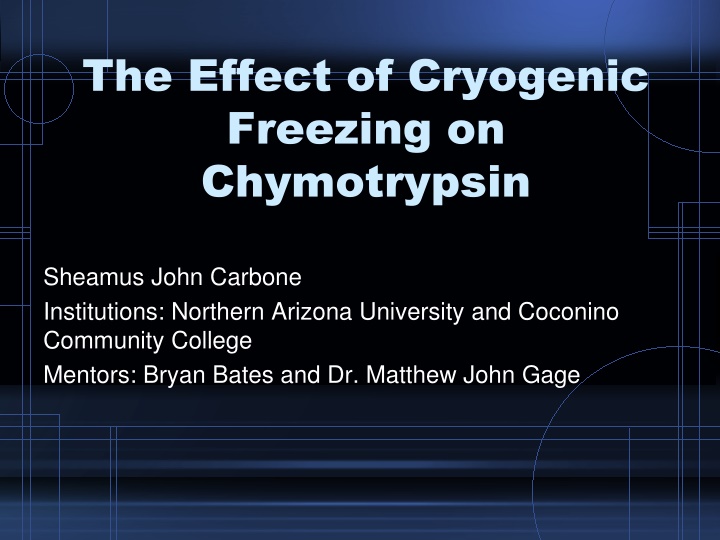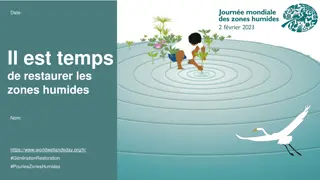
Impact of Cryogenic Freezing on Chymotrypsin Activity
This research study examines the effects of cryogenic freezing on the activity of the digestive enzyme chymotrypsin. By subjecting chymotrypsin to freezing conditions and analyzing its activity over time, the study aims to understand the impact of different cryopreservation methods on enzyme functionality. The data collection process involved testing 16 different solutions under varying freezing conditions and temperatures, followed by thorough analysis of over 131,000 data points. Initial findings suggest significant changes in enzyme activity after prolonged freezing periods, particularly in brain-related enzymes. Ongoing data analysis may reveal insights into potential applications in cell isolation techniques.
Download Presentation

Please find below an Image/Link to download the presentation.
The content on the website is provided AS IS for your information and personal use only. It may not be sold, licensed, or shared on other websites without obtaining consent from the author. If you encounter any issues during the download, it is possible that the publisher has removed the file from their server.
You are allowed to download the files provided on this website for personal or commercial use, subject to the condition that they are used lawfully. All files are the property of their respective owners.
The content on the website is provided AS IS for your information and personal use only. It may not be sold, licensed, or shared on other websites without obtaining consent from the author.
E N D
Presentation Transcript
The Effect of Cryogenic Freezing on Chymotrypsin Sheamus John Carbone Institutions: Northern Arizona University and Coconino Community College Mentors: Bryan Bates and Dr. Matthew John Gage
Introduction Enzymes are naturally and technologically subjected to extreme environments. Freezing conditions influence an enzyme s lifetime Freeze human tissues
Freezing and Cryoprotectants Why Cryogenically freezing enzymes? Preservation? Cryopreservation of human tissue technological intervention Snap freezing in liquid nitrogen vs gradual freezing in freezer Various cryoprotectants that exist in nature (frogs/glucose, insects/sugars, salamanders/glycerol) and manmade/DMSO
Chymotrypsin Chymotrypsin is a digestive enzyme that is used to break down proteins into amino acids (organic compound) and polypeptides (organic polymer forming protein molecules) in the body. http://www.worthington-biochem.com/chy/default.html
Data 16 different solutions (6 wells/samples each) 2 freezing conditions (snap and freezer) each at 2 freezing temperatures (-80*C and -20*C) Thawed tor 30 minutes and heated to target temperature of 37*C The data was taken over a 12 week period by putting each solution in 6 wells of a tray and mixing it with a potassium phosphate solution (7.4 pH buffer). After, it was put into a spectrophotometer light for reading (absorbance of light over time)
Analysis After data collection Roughly, 131,000 data points were taken in relation to time Calculated the maximum velocity, the average, and the standard deviation of each sample (slope of the tangent line) and compared to the similar plates over time Burst Phase vs Burst Phase
Conclusions Some enzymes have a large change in activity after six months of freezing Enzymes more involved in the brain as they react differently than other enzymes in the body Potential cell isolation Data analysis is ongoing, but initial analysis shows
Acknowledgements Any Questions? Arizona Space Grant Consortium NAU/NASA Space Grant Program Northern Arizona University Coconino Community College Kathleen Stigmon Dr. Nadine Barlow Dr. Matthew John Gage Bryan Bates Kevin Mullins Dr. Andrew Koppisch nasa logo https://nasa.asu.edu/2014-2015-symposium- presentation- submission?destination=node%2F493


